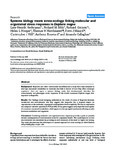Systems biology meets stress ecology: linking molecular and organismal stress responses in Daphnia magna.
| dc.contributor.author | Heckmann, L-H | en |
| dc.contributor.author | Sibly, RM | en |
| dc.contributor.author | Connon, R | en |
| dc.contributor.author | Hooper, HL | en |
| dc.contributor.author | Hutchinson, TH | en |
| dc.contributor.author | Maund, SJ | en |
| dc.contributor.author | Hill, CJ | en |
| dc.contributor.author | Bouetard, A | en |
| dc.contributor.author | Callaghan, A | en |
| dc.date.accessioned | 2017-05-17T08:51:16Z | |
| dc.date.available | 2017-05-17T08:51:16Z | |
| dc.date.issued | 2008 | en |
| dc.identifier.uri | http://hdl.handle.net/10026.1/9268 | |
| dc.description.abstract |
BACKGROUND: Ibuprofen and other nonsteroidal anti-inflammatory drugs have been designed to interrupt eicosanoid metabolism in mammals, but little is known of how they affect nontarget organisms. Here we report a systems biology study that simultaneously describes the transcriptomic and phenotypic stress responses of the model crustacean Daphnia magna after exposure to ibuprofen. RESULTS: Our findings reveal intriguing similarities in the mode of action of ibuprofen between vertebrates and invertebrates, and they suggest that ibuprofen has a targeted impact on reproduction at the molecular, organismal, and population level in daphnids. Microarray expression and temporal real-time quantitative PCR profiles of key genes suggest early ibuprofen interruption of crustacean eicosanoid metabolism, which appears to disrupt signal transduction affecting juvenile hormone metabolism and oogenesis. CONCLUSION: Combining molecular and organismal stress responses provides a guide to possible chronic consequences of environmental stress for population health. This could improve current environmental risk assessment by providing an early indication of the need for higher tier testing. Our study demonstrates the advantages of a systems approach to stress ecology, in which Daphnia will probably play a major role. | en |
| dc.format.extent | R40 - ? | en |
| dc.language | eng | en |
| dc.language.iso | eng | en |
| dc.subject | Animals | en |
| dc.subject | Anti-Inflammatory Agents, Non-Steroidal | en |
| dc.subject | Daphnia | en |
| dc.subject | Ecotoxicology | en |
| dc.subject | Eicosanoids | en |
| dc.subject | Embryonic Development | en |
| dc.subject | Fertility | en |
| dc.subject | Gene Expression Profiling | en |
| dc.subject | Ibuprofen | en |
| dc.subject | Oligonucleotide Array Sequence Analysis | en |
| dc.subject | Phenotype | en |
| dc.subject | Systems Biology | en |
| dc.title | Systems biology meets stress ecology: linking molecular and organismal stress responses in Daphnia magna. | en |
| dc.type | Journal Article | |
| plymouth.author-url | https://www.ncbi.nlm.nih.gov/pubmed/18291039 | en |
| plymouth.issue | 2 | en |
| plymouth.volume | 9 | en |
| plymouth.publication-status | Published | en |
| plymouth.journal | Genome Biol | en |
| dc.identifier.doi | 10.1186/gb-2008-9-2-r40 | en |
| plymouth.organisational-group | /Plymouth | |
| plymouth.organisational-group | /Plymouth/Research Groups | |
| plymouth.organisational-group | /Plymouth/Research Groups/BEACh | |
| plymouth.organisational-group | /Plymouth/Users by role | |
| dc.publisher.place | England | en |
| dcterms.dateAccepted | 2008-02-21 | en |
| dc.identifier.eissn | 1474-760X | en |
| dc.rights.embargoperiod | Not known | en |
| rioxxterms.versionofrecord | 10.1186/gb-2008-9-2-r40 | en |
| rioxxterms.licenseref.uri | http://www.rioxx.net/licenses/all-rights-reserved | en |
| rioxxterms.licenseref.startdate | 2008 | en |
| rioxxterms.type | Journal Article/Review | en |


